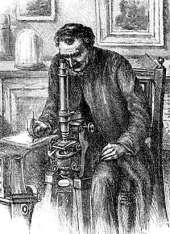
|
Editorial. Micrographia Site News. Comments on Current Events. |
Page 1 of 1 |

|
Editorial. Micrographia Site News. Comments on Current Events. |
Page 1 of 1 |
|
Greetings and Welcome.  The title page of Robert Hooke's seminal publication of 1665 reads: "Micrographia: or some Physiological Descriptions of Minute Bodies made by Magnifying Glasses with Observations and Inquiries Thereupon." and serves equally well to introduce the present web site, some three hundred and thirty odd years on.
The title page of Robert Hooke's seminal publication of 1665 reads: "Micrographia: or some Physiological Descriptions of Minute Bodies made by Magnifying Glasses with Observations and Inquiries Thereupon." and serves equally well to introduce the present web site, some three hundred and thirty odd years on.
Since Hooke, and particularly since the 1930s, several new kinds of microscope have made their appearance -- the various forms of electron microscope, the accoustic microscope, and more recently the scanning tunneling and atomic force microscopes -- and have made enormous contributions to our perception of detail lying beyond the reach of normal vision. The light microscope has itself been augmented with phase contrast, differential interference contrast, and laser confocal scanning systems which have further extended its unique attribute -- the ability to observe the structure and behaviour of living creatures. The innovative use of this feature is a central concern of Micrographia. 
The late 1800s saw a dramatic improvement in the light microscope at the hands of Abbe at Zeiss (with major contributions from the glass chemist Schott and the mathematician Seidel). It was the age in which Pasteur, Koch and Ehrlich, using microscopes able to clearly distinguish between the different forms of bacteria, laid the foundations for our understanding of the role of those organisms in disease. Not surprisingly, the microscope was seen by scientists of the time as the most valuable and necessary instrument of research, and in the wider community, as a source of general wonder and the educated gentleman's pastime. It was the instrument which most characterized the exciting science of the time. Since that heyday, the light microscope in its various forms has become such a ubiquitous and routine tool in so many fields of science and industry that it is presently suffering some of the contempt (or at least neglect) that accompanies familiarity. Fortunately, there are those of us who are aware that, inasmuch as the microscope is the product of human art, there is an art required of those who use it. Micrographia is dedicated to the communication of that art. 
Not just any microscope and any human being, but a seriously curious, resourceful and patient human being, having access to a microscope of sufficient (or better) quality to satisfy the visual sense, and able to deploy it with a technique doing justice to the innately fascinating creatures and phenomena made visible. Micrographia is devoted to the service of that fascination. |